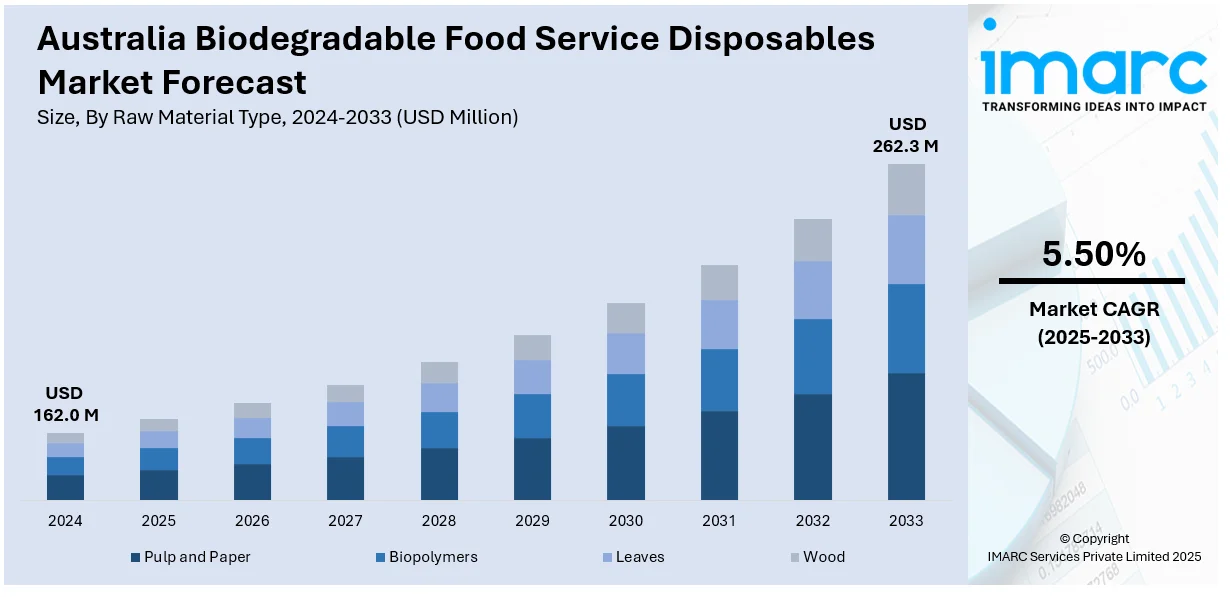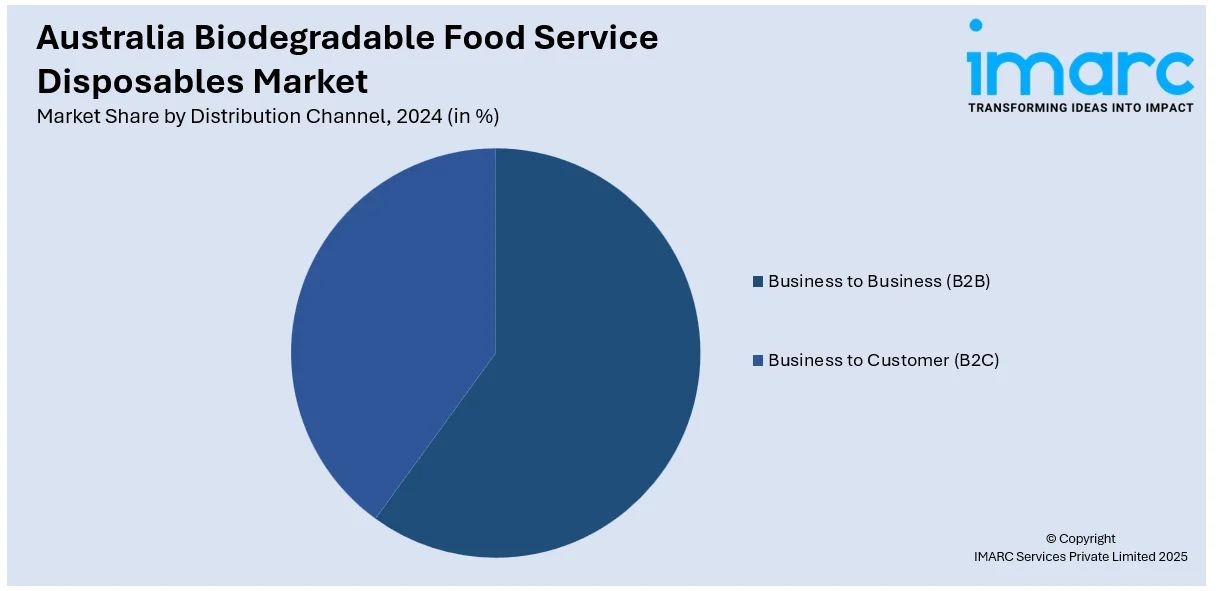
Australia Biodegradable Food Service Disposables Market Size, Share, Trends and Forecast by Raw Material Type, Product Type, Distribution Channel, and Region, 2025-2033
Australia Biodegradable Food Service Disposables Market Overview:
The Australia biodegradable food service disposables market size reached USD 162.0 Million in 2024. Looking forward, IMARC Group expects the market to reach USD 262.3 Million by 2033, exhibiting a growth rate (CAGR) of 5.50% during 2025-2033. The market is driven by the substantial change in attitudes toward environmental sustainability, implementation of government regulations and ban on single-use plastics, and accelerated growth of takeaway options and food delivery services in Australia.
|
Report Attribute
|
Key Statistics
|
|---|---|
|
Base Year
|
2024 |
|
Forecast Years
|
2025-2033
|
|
Historical Years
|
2019-2024
|
| Market Size in 2024 | USD 162.0 Million |
| Market Forecast in 2033 | USD 262.3 Million |
| Market Growth Rate 2025-2033 | 5.50% |
Australia Biodegradable Food Service Disposables Market Trends:
Rising Environmental Awareness and Consumer Preference for Sustainable Products
Australia is experiencing a substantial change in consumers' attitudes and a shift towards environmental sustainability which is exerting a strong impact on purchasing habits in industries, particularly in food service. According to the data of the Australia Institute, by 2050, the amount of plastic consumed in Australia will reach more than double. The growing public debate on plastic pollution, ocean litter, and global warming is creating awareness about the harm inflicted on the environment by traditional single-use plastics. People are increasingly looking for alternatives that reflect values of eco-friendliness and demanding biodegradable and compostable food service disposables. The market is reaping the rewards of this behavioral shift, with green packaging no longer a niche but an anticipated norm. Food service companies, from local cafes to national fast-food restaurants, are adapting by making the switch to plant-based packaging materials such as bagasse, polylactic acid (PLA), and paper-based packaging. This is further supported by people’s willingness to pay extra for green alternatives, which is turning sustainability into a competitive edge.

To get more information on this market, Request Sample
Government Regulations and Ban on Single-Use Plastics
Australian federal and state government legislation is encouraging the use of biodegradable food service disposables. As the issue of plastic waste management gains traction, the government is enforcing severe bans on several single-use plastic products, such as cutlery, straws, and containers. South Australia, Queensland, and New South Wales are imposing bans, while others are expected to do the same under the National Plastics Plan. From September 2025, ban on non-Australian Standard (AS) certified compostable plastic labels on produce (fruit or vegetables) for sale in South Australia will be imposed. These regulations motivate food service operators, caterers, and packaging providers to switch quickly to compliant substitutes, including biodegradable disposables. In most instances, this regulatory momentum is creating a first-mover benefit for companies already selling or using sustainable alternatives. Additionally, economic incentives, certifications, and government procurement policies promoting green products is bolstering the market growth.
Growth of the Food Delivery and Takeaway Industry
The accelerated growth of takeaway and food delivery services in Australia is driving the demand for disposable food service items, especially in suburban and urban regions. Online food delivery platforms are experiencing growth. With the rise in the adoption of single-use packaging for delivery orders, there is greater scrutiny of the environmental footprint of such packaging materials. This shift is catalyzing the need for environment friendly packaging options. Biodegradable disposables offer an alternative to plastic packaging, allowing food companies to address both functionality needs and ecological requirements. Restaurant, food truck, and cloud kitchen demand for durable yet compostable packaging. This is encouraging manufacturers to create innovative moisture- and grease-resistant biodegradable packaging. This confluence of convenience and sustainability renders biodegradable solutions a smart business decision for companies looking to stand out in a competitive and environmentally mindful food delivery market. The IMARC Group predicts that the Australia online food delivery market size is expected to reach USD 20.3 Billion by 2033.
Australia Biodegradable Food Service Disposables Market Segmentation:
IMARC Group provides an analysis of the key trends in each segment of the market, along with forecasts at the country and regional levels for 2025-2033. Our report has categorized the market based on raw material type, product type, and distribution channel.
Raw Material Type Insights:
- Pulp and Paper
- Biopolymers
- Leaves
- Wood
The report has provided a detailed breakup and analysis of the market based on the raw material type. This includes pulp and paper, biopolymers, leaves, and wood.
Product Type Insights:
- Cups
- Clamshells and Containers
- Plates
- Cutleries
- Others
A detailed breakup and analysis of the market based on the product type have also been provided in the report. This includes cups, clamshells and containers, plates, cutleries, and others.
Distribution Channel Insights:

- Business to Business (B2B)
- Business to Customer (B2C)
- Supermarkets and Hypermarkets
- Online Stores
- Others
A detailed breakup and analysis of the market based on the distribution channel have also been provided in the report. This includes business to business (B2B) and business to customer (B2C) (supermarkets and hypermarkets, online stores, and others).
Regional Insights:
- Australia Capital Territory & New South Wales
- Victoria & Tasmania
- Queensland
- Northern Territory & Southern Australia
- Western Australia
The report has also provided a comprehensive analysis of all the major regional markets, which include Australia Capital Territory & New South Wales, Victoria & Tasmania, Queensland, Northern territory & Southern Australia, and Western Australia.
Competitive Landscape:
The market research report has also provided a comprehensive analysis of the competitive landscape. Competitive analysis such as market structure, key player positioning, top winning strategies, competitive dashboard, and company evaluation quadrant has been covered in the report. Also, detailed profiles of all major companies have been provided.
Australia Biodegradable Food Service Disposables Market Report Coverage:
| Report Features | Details |
|---|---|
| Base Year of the Analysis | 2024 |
| Historical Period | 2019-2024 |
| Forecast Period | 2025-2033 |
| Units | Million USD |
| Scope of the Report |
Exploration of Historical Trends and Market Outlook, Industry Catalysts and Challenges, Segment-Wise Historical and Future Market Assessment:
|
| Raw Material Types Covered | Pulp and Paper, Biopolymers, Leaves, Wood |
| Product Types Covered | Cups, Clamshells and Containers, Plates, Cutleries, Others |
| Distribution Channels Covered |
|
| Regions Covered | Australia Capital Territory & New South Wales, Victoria & Tasmania, Queensland, Northern Territory & Southern Australia, Western Australia |
| Customization Scope | 10% Free Customization |
| Post-Sale Analyst Support | 10-12 Weeks |
| Delivery Format | PDF and Excel through Email (We can also provide the editable version of the report in PPT/Word format on special request) |
Key Questions Answered in This Report:
- How has the Australia biodegradable food service disposables market performed so far and how will it perform in the coming years?
- What is the breakup of the Australia biodegradable food service disposables market on the basis of raw material type?
- What is the breakup of the Australia biodegradable food service disposables market on the basis of product type?
- What is the breakup of the Australia biodegradable food service disposables market on the basis of distribution channel?
- What is the breakup of the Australia biodegradable food service disposables market on the basis of region?
- What are the various stages in the value chain of the Australia biodegradable food service disposables market?
- What are the key driving factors and challenges in the Australia biodegradable food service disposables market?
- What is the structure of the Australia biodegradable food service disposables market and who are the key players?
- What is the degree of competition in the Australia biodegradable food service disposables market?
Key Benefits for Stakeholders:
- IMARC’s industry report offers a comprehensive quantitative analysis of various market segments, historical and current market trends, market forecasts, and dynamics of the Australia biodegradable food service disposables market from 2019-2033.
- The research report provides the latest information on the market drivers, challenges, and opportunities in the Australia biodegradable food service disposables market.
- Porter's five forces analysis assist stakeholders in assessing the impact of new entrants, competitive rivalry, supplier power, buyer power, and the threat of substitution. It helps stakeholders to analyze the level of competition within the Australia biodegradable food service disposables industry and its attractiveness.
- Competitive landscape allows stakeholders to understand their competitive environment and provides an insight into the current positions of key players in the market.
Need more help?
- Speak to our experienced analysts for insights on the current market scenarios.
- Include additional segments and countries to customize the report as per your requirement.
- Gain an unparalleled competitive advantage in your domain by understanding how to utilize the report and positively impacting your operations and revenue.
- For further assistance, please connect with our analysts.
 Request Customization
Request Customization
 Speak to an Analyst
Speak to an Analyst
 Request Brochure
Request Brochure
 Inquire Before Buying
Inquire Before Buying




.webp)




.webp)












